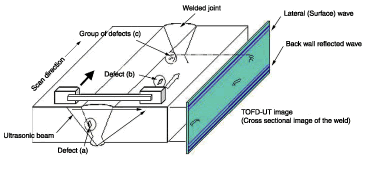TOFD-UT Inspection Technology
Time of Flight Diffraction (TOFD) is different from conventional pulse-echo (PE) ultrasonic examination in that it detects low-amplitude diffracted pulses from flaw edges or tips. Most P-E UT techniques detect high-amplitude reflected pulses from flaws.
Two separate probes, a transmitter and a receiver, are used in a tandem configuration. The probes are placed on either side of a weld with UT beams directed into the weld. A lateral wave travels along the contact surface in between the two probes. The longitudinal wave of the angle beam is reflected from the back wall surface. Flaws generate diffracted pulses that appear in between the lateral wave and back wall signals. All of the R-F A-scan data are recorded and stored in memory for later recall and analysis. The A-scans can then be stacked together to create B-scan or D-scan images that show a cross-sectional view in proportion to the weld thickness and scan position. Additionally, R-F and D-scan images can be viewed in real time as scanning is performed. Because this technique does not rely on detection of reflected pulses, it is not amplitude dependent for flaw detection or measurement.


Example of TOFD-UT inspection technique

